|
June 15, 2005
Interview: Dr. Arya Goes Trekks Through
Nepal - His Most Intense Travel Experience Ever - Physically and
Mentally
I have written about my dentist before who is a really cool guy.
Not only is he a dentist, but he is also a practicing lawyer. More
than that he is also a world traveller and an active global volunteer.
Dr. Arya recently did a treek through Nepal, which he described
as his most challenging travel experience ever, physically and mentally.
Read here about his adventure in Nepal:
1) Please give us a general itinerary of the trip and a
description of the trekk
Our trip was a 12-day trip in which we landed in the Delhi and eventually
made our way by various modes of transportation to the State of
Sikhim, which is in the very northern part of India. Sikhim is a
very controversial state, as it is the subject of many territory
disputes between China and India. However, I believe that China
has just recently officially recognized it as a part of India. The
trekk involved first going to Darjeeling (yes, where the tea originates!),
where we rested up and slightly acclimatized ourselves for 2 or
3 days in a very picturesque, tranquil setting. From there we took
a 7 hour jeep ride up into Yuksom (Sikhim), a little village where
trekkers usually start their journey. The long jeep ride itself
was quite exciting as you are going up mountains on very narrow
roads, and cars are coming from all over not paying particular attention
to which side of the road they should be traveling. One side of
the road has a sheer cliff with no guardrails, and you think you
are going to fall down any moment.
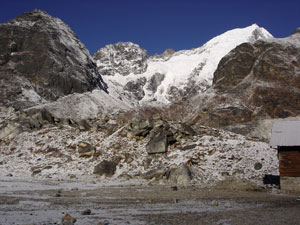
Beautiful Samiti Lake
There were also some hilarious road signs going all the way up,
reminding people to drive slowly: For example, "Don't hurry,
so that you can enjoy your curry", or "Donate your blood
at the blood bank, not on the highway." We really got a chuckle
out of these signs. Finally, after the long ride we made it to our
starting point for the trekk where we stayed in a very basic hotel.
It was probably a one-star hotel; however little did we know that
this would actually be luxury compared to the accommodations that
were still to come.
On our trekk we had with us one sherpa guide, 2 sherpa cooks, and
2 sherpa horsemen for carrying supplies. The carrying animals are
small ponies or yaks, since they are the only animals that can make
it through the rough terrain.
We started the trekk with daypacks- weighing less than 20 pounds.
We also carried water and fancy gear such as climbing poles, fancy
hiking boots, etc. Members of 6 person group also carried medical
and trekking kits. The heavier bags were put on the animals and
taken up. So, we were excited and ready to go.
Basically, every day we walked about 20 km or so which took about
9 hours to do. We typically walked uphill for 8 or 9 hours straight
with a one hour lunch break through various terrains. The vegetation
changes the higher up you go. We started at an altitude of about
2000 m where the vegetation was very green and lush. As we got to
4000 m (equivalent to the top of the European Alps) around the second
or third day of the trekk, we started to see rhododendrons fade,
less green and more shrubs. We spent about a day at that altitude
to acclimatize ourselves.
We stayed in wood huts or tents that had no electricity, no running
water, no furniture, no plumbing, or no heat. The nights got really
cold, so the sherpas would boil water and fill it into our drinking
bottles. We took those hot bottles and put them into our sleeping
bags to keep warm. The next day we used the same water as drinking
water. For the entire 8 days we did not really substantially change
our clothes; we just changed socks in order to avoid blisters. You
certainly don't want to expose skin too long in this environment.
Interestingly enough, at about 4000 m I actually got a severe headache,
my nose started bleeding, and my ears were ringing really bad. Every
night we would have debriefings: however that night I did not participate
in the debriefing since I wasn't feeling well at all. I was very
quiet. I took some diamoxx to help me more quickly adjust to the
altitude.
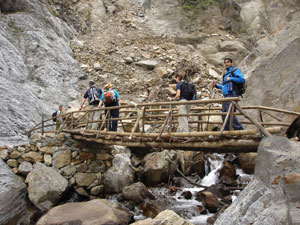
The next day I felt better, and we kept on going up. At about 4500
m we started to see snow and sleet. At about 5000 m we reached Samiti
Lake, which is a high altitude lake. It is very odd to see a little
lake in the middle of these mountains. We camped out there, this
was our pinnacle day.
The next day we aimed to go to Lagochla which was going to be the
high altitude point for the trekk. Of the 6 people in our group,
4 of us decided to make it to Lagochla. Last year 6 Germans actually
died on this stretch because of an avalanche. They had been instructed
by the sherpas not to go, but they went anyway- killing themselves
and a poor porter.
To reach Lagochla we left at 2 am, when it was pitch dark outside.
We had headlights on our heads and followed closely on the guide's
footsteps. We were literally walking on the edge of cliffs at times.
You don’t know how far down the cliff is- it could be 2 feet
or 200 feet. All you can do is just concentrate and keep on walking.
At 2:30 am, my hands started hurting because of the cold. Since
it was so early into the trekk I did not want to say anything and
embarrass myself. Right about that time, the girl in front of me
stopped and started to complain about the same thing. We all stopped
to evaluate the situation. She pulled out a heat pack to warm her
hands. I found that the act of moving fingers back and forth quickly
actually calmed our fingers down. We continued to climb and at 4:45
am we reached our pinnacle. We didn't go any further than that.
We had hit Lagochla I. Lagochla III was slightly ahead and was to
be our planned destination; however the sherpas felt it was too
dangerous to continue. There was some heavy debate amongst them
and then us. We decided we were done and would watch the sunrise
from this point. Then we all did a little prayer with the sherpas.
We savoured the view, which is, of course, unbelievably beautiful.
We were very close to Katchachamanga, the 3rd highest peak in the
world. The view was truly spectacular. I made a mental note as we
turned around at 5:10 am and I thought of my wife, saying to myself
"I am coming home". Little did I know that the walk back
was extremely hard as well, it was very slippery and dangerous and
very hard on the knees. At that point we were 4 days into the hard
trekk and we had another 4 days to go.
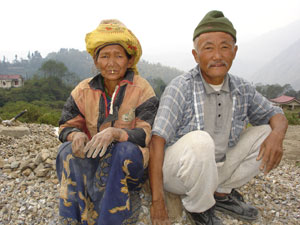
The "Stonebreakers"
After our early morning trip to Lagochla, we got back to the camp
at 8:30 am. We had breakfast and then we walked another 9 hours.
We slowly made our way down, 8 or 9 hours every day. On the second
last day of the trekk, one group member got very violently ill.
At one time she actually threw up 9 times an hour. She was completely
zapped of energy. On the last day, another group member got sick.
At this point, I decided to talk to the leader since I am familiar
with this type of illness. I figured both of them just needed rest,
why don't I take them down as quickly as possible to the hotel.
Coming down slower would be even more painful for these guys as
they had the mental fortitude and physical tenacity to make a ‘run’
for it. We would aim for doing it in 6 hours instead of 9. So a
decision was made that I would take them down. The 2 sick people
and myself rushed down and we indeed made it in 6 hours. Making
it down safely was an incredible experience. I felt it was a real
physical and mental feat.
After rushing down from the mountains we arrived in the little dusty
town where we had started and we felt like cowboys riding in. The
locals were sitting around in the heat watching three dusty travellers
limp through their town with smiling faces. We were told that of
all trekking groups that went up at this time, we were the only
group that had made it to Lagochla, everybody else had turned around.
We were very even more proud of the accomplishment.
One of the sherpas said that Western people always say "we
conquered the mountain". Eastern people, on the other hand,
say "the mountain let us pass". I am a firm believer of
the latter. The rest of group came down a couple of hours later,
exhilirated to make it back safely. We were all in a state of shock
due to exertion, but we were happy as well.
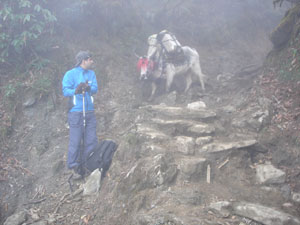
Descending with the pack-yak
3) Please comment on practical aspects of the trekk: accommodation,
food, equipment, fitness level required
Obviously, one has to be in decent shape to do this sort of trek.
I am not certain one needs to be a marathoner etc. do complete it.
I was in good shape anyway as I run and work out quite a bit. From
a cardio perspective, I did not feel exerted. I did feel exerted
tremendously from a muscular perspective as the duration of each
trekking day was quite long. The trek can be hard on your knees
and feet.
We all had very high quality mountain boots and packs. We had breathable
clothes and socks. We would carry water bottles during the day along
with high energy food stuffs like peanut brittle.
As far as accommodation goes-well, what accommodation?
I would, however, recommend that if one elects to go on this type
of journey then they be in good shape of course. Get your cardio
to a point where you are not huffing and puffing after a 30 minute
jog. The mental training would be equally important. Read about
the details of these types of trips and learn what to expect. Try
to take some of the surprise out of it. It may help.
4) Please tell us about the mental components of the trekk
(insights, learning experiences, emotions, spiritual experiences)
The nights would be so incredibly cold, I was freezing and almost
in state of delirium. I wrote in my journal every day describing
what we all were going through. I had pictures of my wife and daughter
with me to which I would stare at every night. I found myself touching
the pictures, longing for my family. I can honestly say that I missed
them so much. Of course I couldn’t speak with them since there
are no phones along the trekk. This was a really incredible feeling
- this intense longing, I could not believe the intensity of this
feeling..
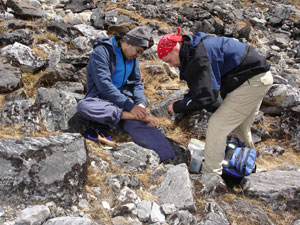
Tending to blisters
The mental stress that you feel as a result of the conditions is
very difficult. You have to go to the washroom outside, live with
the cold (and heat) and deal with very poor sanitary conditions.
This is difficult. It wears you down. The group was very strong
mentally. We would pick each other up often and make each other
laugh. I took the role on this trip as the person who would try
to make everyone laugh when times got tough. I believe I took the
role of the silent leader. We had designated leaders on the trip.
As I felt mostly strong through the trip, I found I could often
be used as a pillar when times got tough. I was lucky.
The reflection for this trip became more accurate as some time
elapsed. In other words, it was difficult to fully enjoy the beautiful
sights and sounds during the trek. However, upon my return and looking
at the photos etc. I started to reflect in a more positive manner.
It was a difficult trip; however, I realized that this trip was
not about getting to a destination or saying you made it to a certain
point. This trip was about the struggles, fun, exhilaration, companionship,
and commentary along the way. I suppose- much like life! Seeing
the beautiful sunrise at LaGochla or the peak of Everest from Darjeeling
are really just minor events. The amount I learned about people
and myself as we slowly and deliberately walked through rough terrain
was incredible. Yes, the journey and not just the destination is
what it was all about.
5) Please comment on the cultural components of the trip
(contact points with locals, exposure to cultures, political insights
etc.)
India, in general, is a fascinating and complicated place. I don’t
think a real traveler should miss the adventure of traveling to
the sub-continent.
The trek offered us some exposure to the Nepalase/Tibetian way
of life. A seemingly simpler life with simple wants and needs. In
addition, the usual and controversial effects of globalization are
obviously apparent including the environmental issues. There is
plenty of garbage left on the trails by Westerners as a result of
the ever increasing number of people going on these types of treks.
This is obviously quite disturbing.
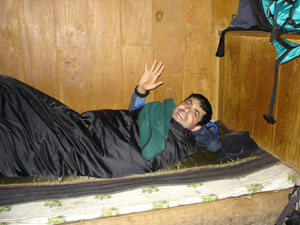
"Luxury" accommodation....
The Sherpas were absolutely fascinating. First of all, we were
quite humbled by them. Physically, they were in such superior shape.
It was really something to see. They are very respectful of the
mountains, the environment and to people in general. They are very
accommodating, pleasant and knowledgeable about the mountains. Some
of them would be carrying 100 pound loads on their backs and trotting
up the hills like a Sunday stroll. Each time this happened, and
it happened a lot, I would just watch in absolute awe.
6) Please tell us about the after-effects of the trekk
Since coming back it has taken me about a month to recover. Although
I was 100% functional, something wasn't quite right, something just
didn't feel right. Physically I was slightly off, I felt clumsy.
After the trip I wanted to read more about the Himalayas, and since
then I have read 4 books on the Himalayas, including two about the
famous tragedy in 1996 when several climbers that died up there.
There are also some amazing survival stories connected to this event.
What started out as an interest in where I had been, lately has
been, I must confess, a minor obsession to return. I have experienced
more enthusiasm about going back, maybe trying an extreme climb,
an adventure 2 notches higher than this trekk. I am grappling with
that because I would really want to do something like that. But
there is tremendous pressure from my family not to do it since they
were worried sick about me while I was away on my trekk. The rational
part of mind also agrees. I fully agree that there is no point in
me trying to do something silly. I have a wife, child and another
one on the way. I was lucky to go on this trip.
Thank you so much, Dr. Arya, for sharing your experiences with us
from this exciting and unusual travel experiences.
Interesting books about the Himalayas:
Related Articles:
My dentist - A really cool
guy
Interview with Dr. Arya - dentist, lawyer,
world traveler, philanthropist
|